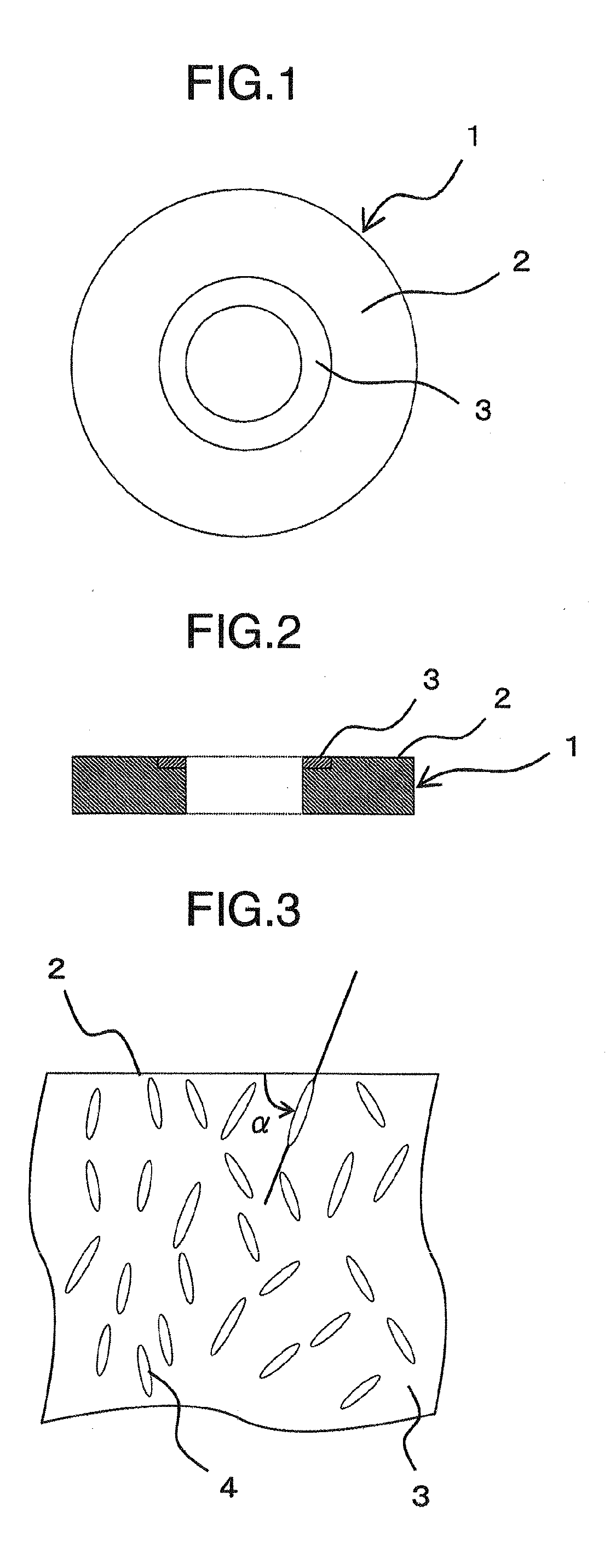[0006]However, since the needle-like Mn-Si-based compound dispersed in the matrix extends in a direction parallel to the surface of the sliding portion, that is, a major axis of the needle-like Mn-Si-based compound is in parallel with the sliding face, in JP-A-2003-42145, about a half of outer surface of a grain of the needle-like Mn-Si-based compound exposes on the sliding surface and does not bound to the brass matrix. Thus, the grain is easily subjected to be sheared by sliding and detached from the surface of the bearing. The detached Mn-Si-based compound may behave as a
foreign matter, and possibly damage the surface of the bearing and the shaft during sliding. Finally, seizure possibly occurs.
[0007]The invention is made in order to solve the above problems. The objective of the invention is to provide a thrust bearing for a turbocharger of an internal-combustion engine having improved seizure resistance.
[0010]By controlling the angle between the major axis direction of the needle-like Mn-Si-based compound in the sectional view perpendicular to the surface to be 30° to 150°, the grains of the needle-like Mn-Si-based compound in the vicinity of the sliding surface can contact the brass matrix, and is tightly fixed to the matrix. As a result, dropout of the grains of the needle-like Mn-Si-based compound due to sliding is inhibited, and seizure can be prevented without damaging the surfaces of the bearing and the shaft while they are sliding. When less than 50% of the total of the grains of the needle-like Mn-Si-based compound make the angle to the surface of the sliding portion being 30° to 150°, a ratio of dropping grains is relatively increased, and the seizure is not be completely prevented.
[0011]The inventors have confirmed that when not less than 50% of the total grains of the needle-like Mn-Si-based compound have a major axis making an angle of 45° to 135° with the surface of the sliding surface, seizure resistance can be improved at a higher level. The depth of the region where the major axis direction of the needle-like Mn-Si is controlled is set at 50 μm from the sliding surface, since the maximum allowable abrasion depth of the thrust bearing in the turbocharger of internal-combustion engine is 50 μm.
[0012]When a temperature of the thrust bearing during operation of the turbocharger is elevated, an arrangement of
metal atoms constituting the brass matrix around the needle-like Mn-Si-based compound has
lattice defects (i.e. lattice strains) strain due to a difference in the
thermal expansion between the brass matrix and the needle-like Mn-Si-based compound on the surface of the sliding portion. The brass matrix having these
lattice defects (i.e. lattice strains) becomes active, and easily reacts with
sulfur in a
lubricant.
[0013]In an embodiment, an average distance between the grains of the needle-like Mn-Si-based compound dispersed in the brass matrix near the surface of the sliding portion may be 5 to 80 μm. Then, an entire brass matrix on the surface of sliding portions in the thrust bearing evenly receives the effect due to the difference in
thermal expansion of the needle-like Mn-Si-based compound, and the entire surface of the sliding portion evenly becomes active, so that a
sulfide film can be early formed on the surface of the brass matrix in the sliding portion. The average distance between the grains means an average distance between the grain of the needle-like Mn-Si-based compound and other closest grain. It means average length of the brass matrix between the grains of the needle-like Mn-Si-based compound. As described, since the nonmetallic
sulfide film is early formed on the surface of the brass matrix during the operation of the turbocharger when the average distance between the grains of the needle-like Mn-Si-based compound dispersed in the brass matrix on the surface of the sliding portion is 5 to 80 μm, while the opposing shaft is made of
metal, sliding between metallic surfaces is prevented, and the seizure resistance of the thrust bearing can be improved.
 Login to View More
Login to View More 
